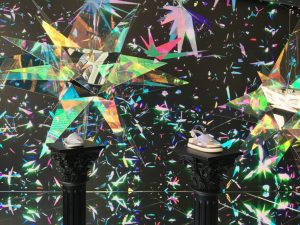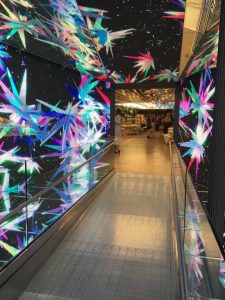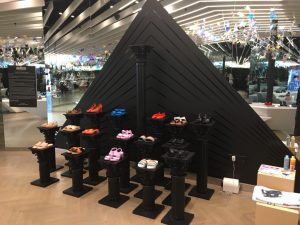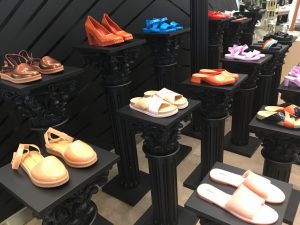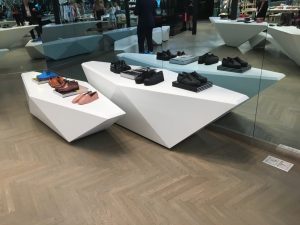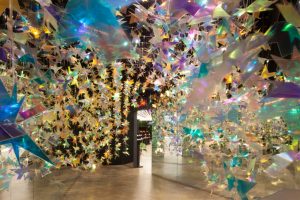We’ve all heard it before. The sky is falling … brick-and-mortar retail is a thing of the past. But is it true? No. Stores are not going away, they’re merely adjusting. The traditional role of the brick-and-mortar environment must be reevaluated.
As retailers continue to scramble in search of a voice that will resonate with customers in today’s digital world, global fashion accessories and shoe brand Melissa connects with its customers as it speaks to the community through the arts in its dazzling SoHo location, a flagship called Galeria Melissa.
Passersby along Broadway are immediately drawn into the space by a slightly inclined bridge immediately past the front door that funnels people through an intergalactic-like animation projected on blackened LCD walls. Two-thousand visitors, tourists and locals alike, cross the enticing bridge each day to visit a store that is so much more than just a store. Michelle Katz of The Creative NYC, Melissa’s public relations partner, calls it “an art gallery disguised as a store.”
In a nod to the creative vibes the district has generated since the influx of artists into loft spaces and the proliferation of art galleries in the ’60s and early ’70s, Melissa features a regularly scheduled calendar of art exhibitions by up-and-coming female artists.
In May, the forward-thinking Brazilian retailer launched a two month exhibition by London-based digital artist Natalia Stuyk. “Paraíso,” which is both Spanish and Portuguese for paradise, is Stuyk’s multimedia installation that includes the artist’s signature dream-like animations projected on all-encompassing floor-to-ceiling LCD paneled walls. In addition, floating crystal facets of colorful light, in the form of 3-D metallic star constructions, add a tactile quality to the installation. The combination of animation and the copious cascade of hanging metallic star cutouts transports the viewer into a playful Star Trek-like galaxy of fun and delight. In an unusual store planning strategy, Melissa allocated prime front and forward retail space for a continuation of the exhibit in a mirrored room dedicated to a transformative experience, immersing viewers in Stuyk’s outer space fantasy.
The artist’s vision and ultimate goal is to place the viewer in the work itself, thereby transporting them to another place. Ironically, it is this kind of transformative experience that should be a core strategy for retailers navigating the industry’s ever-changing currents.
Advertisement
Stuyk's description of her work is in no small measure a reflection of the challenges facing retail today. In recounting the process behind the “Paraíso” installation, the artist exclusively told VMSD, “With this installation in particular, the shard shapes we used come from a shape I use over and over in my videos. Then SOFTlabs interpreted these and designed a shape that could be built. The 3-D render of this design was then used in the video. In this way, we created a symbiosis between the physical and the digital, one informed the other. So to then see people take photos of it (selfies and Instagram moments) and make it digital again is kind of perfect.”
And in further recognition of the concept that art imitates life, especially as it relates to retail, Stuyk said, “I feel really limited by creating work that's only experienced online. I generally only feel moved by art I see in person and I want to create work that could potentially contribute to someone else's experience.” She adds, “This is a new step for me, and being able to translate a digital aesthetic into reality is deeply satisfying.” Retailers, take heed.
Galeria Melissa’s New York flagship isn’t just a place to “get them in and sell,” but rather a place where people can come and spend an hour or two just hanging out. With features such as a living wall of greenery, a pottery demonstration and sale, and of course the rotating art installations, Melissa created a community spot for social interaction and engagement. And while there, visitors can select from Melissa’s unique offerings of “cruelty free” footwear made of “100% real plastic.”
To further underscore their commitment to the community and the architectural heritage of an area rich with cast iron architecture, shoe risers reminiscent of the district’s cast iron Corinthian columns are strategically positioned throughout the space. This mix of art, merchandise, technology and history, juxtaposed by store designer Muti Randolph’s futuristic multisensory vision, offers an environment that will make a visit to Galeria Melissa a must for all visiting the SoHo district of New York City.
Eric Feigenbaum is a recognized leader in the visual merchandising and store design industries with both domestic and international design experience. He served as corporate director of visual merchandising for Stern’s Department Store, a division of Federated Department Stores, from 1986 to 1995. After Stern’s, he assumed the position of director of visual merchandising for WalkerGroup/CNI, an architectural design firm in New York City. Feigenbaum was also an adjunct professor of Store Design at the Fashion Institute of Technology and formerly served as the chair of the Visual Merchandising Department at LIM College (New York) from 2000 to 2015. In addition to being the Editorial Advisor/New York Editor of VMSD magazine, Eric is also a founding member of PAVE (A Partnership for Planning and Visual Education). Currently, he is also president and director of creative services for his own retail design company, Embrace Design.
Advertisement


 Headlines7 days ago
Headlines7 days ago
 Headlines2 weeks ago
Headlines2 weeks ago
 Headlines2 weeks ago
Headlines2 weeks ago
 Headlines2 weeks ago
Headlines2 weeks ago
 John Ryan2 weeks ago
John Ryan2 weeks ago
 Sector Spotlight1 week ago
Sector Spotlight1 week ago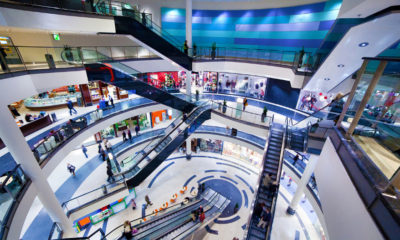
 Headlines2 weeks ago
Headlines2 weeks ago
 Headlines6 days ago
Headlines6 days ago

